

Table of contents
- Fertilizer program starts in autumn
- Horse manure or stable manure
- compost
- green manure
- Planting and fertilizing go hand in hand
- Nutrient supply ends with the flowering period
- Alternatives to compost as potato fertilizer
- Potatoes fertilize with plant manure
- Sheep's wool - innovative supplement for compost & Co.
- Recommended potato fertilizer from the store shelf
- Organic natural compost
- Lime fertilization - a double-edged sword
- Conclusion
The high-yield cultivation of tasty potatoes in harmony with nature is one of the greatest challenges in the home garden. The balanced supply of nutrients assumes a decisive key function in the care program. Since the use of industrial fertilizer is taboo in ecologically managed kitchen gardens, the focus is on organic potato fertilizer. This guide lists the best natural fertilizers, gives tips for the perfect dosage and the ideal time. How to properly fertilize your potato plants
Fertilizer program starts in autumn
When using organic potato fertilizer, chemical ingredients are left out. In order for your potato plants to benefit from the natural nutrients, busy soil organisms are required in advance. Earthworms and microorganisms process organic fertilizer in such a way that it can be absorbed by the roots and is therefore available for the plants. In addition, nutrient stores dormant in the soil are activated so that they can also be used to naturally promote growth. This process requires a time frame of several weeks in summer and a few months in winter. As a result, processed compost and other natural fertilizers strengthen your potato plants for a significantly longer period of time than artificial fertilizers that are effective in the short term.
This short excursion into the basics of natural nutrient supply makes it clear that you should ideally already be active in the potato patch in autumn of the previous year. By taking one of the following preparatory measures or a combination of them, you will give your potato plants the best possible starting conditions.
Horse manure or stable manure
- In the fall, dig up the bed 2 spades deep
- Remove stones, root remains, weeds and thick clods of earth
- Incorporate composted horse manure or stable manure that is at least 18-24 months old
- Undermine the organic material about 1 spade deep at a rate of 3 to 5 liters per square meter
Fresh manure of any kind is not suitable as potato fertilizer. Only after a hot rot, a cooler build-up phase and the humus conversion by hard-working compost worms does fresh manure and manure meet the expectations of a good natural fertilizer for your potato bed.
compost
Where horse manure or stable manure is not available, mature compost takes over the task of preparing the nutrient supply in the fall. The organic material is applied to the broken, cleaned soil in a dosage of 5 liters per square meter. Please do not rake in compost as deep as manure or manure. The potato fertilizer should be available where the majority of soil organisms reside. When measuring the quantity, bear in mind that heavily consuming plants will find their way into the prepared potato bed in spring.
green manure
As an alternative or in combination with manure and compost, we recommend sowing green manure on the surface of the planned potato patch. Winter-hardy seed mixtures, such as Landsberger Gemenge or Terra-Life Solanum, leave loose, well-aerated soil rich in oxygen and nitrogen in spring. In addition, green manure suppresses annoying weeds. How to do it right:
- Rake the bed surface and smooth repeatedly with the rake
- Distribute the seed of the green manure widely on it
- Rake in the seeds and press down with a lawn roller
Finally, water the seed with a fine spray and mark the bed so that no one steps on it again. During the winter, care is limited to watering when it is dry, when neither snow nor rain provide the necessary moisture. Before you start planting your potatoes, mow or scythe the green manure and work the plant remains into the clod.
Tip:
Gardening practice has shown that consistent fertilizing with compost keeps the dreaded potato beetle at bay. In addition, a clever mixed culture effectively prevents the devastating late blight by sowing marigolds, spinach, parsley or nasturtium in the potato bed.
Planting and fertilizing go hand in hand
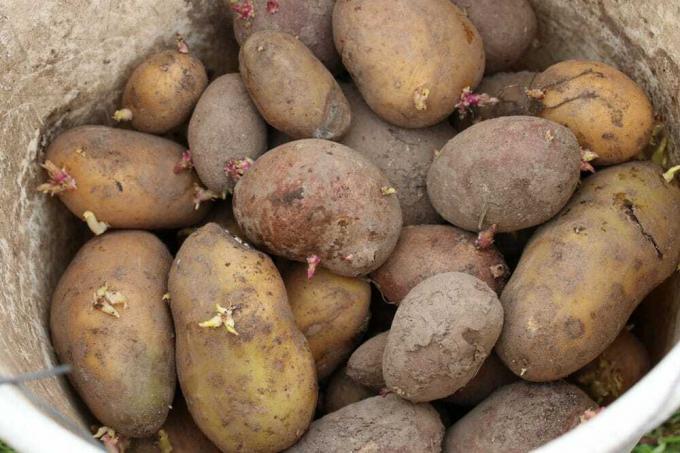
If seed potatoes are planted in the soil, they will find - thanks to the soil preparation in the previous year - an active soil life with a wide range of nutrients. So that it stays that way during the long cultivation period until the autumn harvest time, refresh the natural fertilizer now. Early fertilization is particularly important when growing potatoes, because before Closed in rows in the bed, the nitrogen requirement is at its highest level and decreases until the flowering period significantly. How to start the fertilizer program at planting time:
- Work in mature compost before planting potatoes in the bed
- A dosage of 2 to 3 liters per square meter is ideal
- In addition, sprinkle a few handfuls of horn shavings or horn meal over the compost
By mixing compost and horn shavings, both natural fertilizers promote each other's effectiveness, which benefits the germination and growth of your potato plants. Therefore, place the seed potatoes on the recommended nutrient bed with a 5 cm high soil cover and then water.
Nutrient supply ends with the flowering period
After the initial fertilization at planting time in April/May, potato plants need regular fertilizer until the end of the flowering period. If you prefer compost as potato fertilizer, give about three liters of the material per square meter every two weeks. So that the nutrients are absorbed quickly, please water generously after each fertilization. Continuing to feed after flowering is a waste of valuable resources. Further doses of nitrogen only force the growth of the leaves, which is ultimately at the expense of the coveted tubers.
Tip:
When young potato plants have reached a height of 15 cm, they are regularly piled up. For this purpose, the raked, finely crumbly soil is used up to the shoots. The reward for the little effort is a higher yield, better taste and longer shelf life for stored potatoes.
Alternatives to compost as potato fertilizer
Homemade compost is considered a premium fertilizer for potato plants. If there is no way in the garden to manage your own compost heap, home gardeners use the following potato fertilizers as an alternative. These options are available for organic nutrient supply:
Potatoes fertilize with plant manure
Plant manure contains the concentrated power of nature to supply ornamental and useful plants with all the important nutrients. Stinging nettle manure in particular distinguishes itself as an excellent organic potato fertilizer thanks to its high nitrogen content. Supplemented with potassium-rich comfrey manure, a valuable natural fertilizer is created which, thanks to its liquid form, is quickly available for potato plants. Production and administration are extremely simple. That is how it goes:
- Fill a wooden tub with 10 liters of rainwater
- Place 500 grams each of fresh nettle and comfrey leaves in a coarse-meshed sack
- Put the sack in the water and cover the vat with chicken wire
- Stir daily until fermentation is complete
- To reduce the odor, stir in rock flour, bentonite, chamomile or valerian leaves
The fermented, sieved plant manure is diluted with water in a ratio of 1:10. Spray the soil once a week in the early morning or in the evening until the end of the flowering period. By mulching with comfrey and nettle leaves at the same time, the effectiveness of the organic fertilizer is increased.
Sheep's wool - innovative supplement for compost & Co.
The knowledge of sheep's wool as a rich, organic fertilizer was long lost and was recently rediscovered. Unwashed sheep's wool contains important main nutrients such as nitrogen, potassium, phosphorus and sulphur. When the material goes into the soil, it loosens the topsoil and regulates the pH value. Thanks to a high level of water storage, sheep's wool absorbs three times its own weight in moisture in order to successively release it to the surrounding plant roots.
Applied once, sheep's wool supports the growth of potato plants over the entire cultivation period. Ideally, you combine the innovative fertilizer with compost, horn shavings or plant manure, as it is not sufficient as a single fertilizer for heavy consumers. You can purchase sheep's wool in its original form from specialist retailers. The fertilizer is easier to administer as pellets, which are buried 5 cm deep and doused with water.
Recommended potato fertilizer from the store shelf
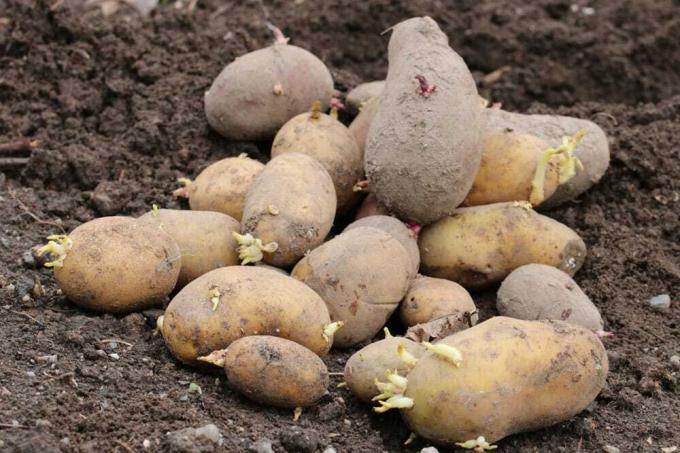
Compost, horn shavings and plant manure are very popular as organic potato fertilizer. However, if you do not have access to these fertilizers, the specialist trade has a wide range of ready-to-use alternatives. Fertilize your potato plants in harmony with nature with the following products:
Potato fertilizer from Cuxin
The special fertilizer scores with the NPK formulation 5+4+15, the components of which are exclusively of natural origin. The high potassium content guarantees a high-yield harvest and contributes to the perfect aroma. The dust-free granulate is sprinkled onto the floor in a dosage of 80 to 150 grams per square meter and rubbed in with rain. The content of a 1.5 kg carton is sufficient for an 18 square meter bed or 50 potato plants.
Organic natural compost
For a long time, manufacturers have been working on how best-quality mature natural compost can be sold as a finished product. Today, numerous well-known suppliers have peat-free organic compost in their range, which is also approved for the commercial organic cultivation of potatoes and other vegetables. Since more than 90 percent of our moors have already been destroyed as a result of peat extraction, please pay attention to a peat-free product when purchasing.
Organic vegetable fertilizer from Compo
To properly fertilize your potato plants, a good vegetable fertilizer meets the requirements just as well as a special fertilizer. Compo's organic vegetable fertilizer is conveniently administered as a liquid fertilizer by adding it to the irrigation water. This makes it particularly suitable if you are growing potatoes in large tubs.
Nature's organic food for fruits and vegetables
The organic liquid fertilizer consists exclusively of natural raw materials and is approved for organic cultivation. Thanks to its liquid form, it is equally suitable for beds and balconies.
Organic fertilizer made from algae from Shropshire Seaweed
An innovative fertilizer that enjoys top ratings among home gardeners is primarily based on algae from the Atlantic. The liquid fertilizer has such a strong effect on growth and yield that it is diluted at a ratio of 1:500. The natural fertilizer not only stimulates the plants in the potato patch, but also in other vegetable patches and flower borders.
Dehner organic fertilizer for fruit and vegetables
The manufacturer took the beneficial effects of stable manure as a potato fertilizer as an opportunity to create a ready-to-use organic fertilizer from it. Poultry droppings are rich in nitrogen, which benefits potato plants until flowering. This makes this product the ideal option for home gardeners who do not have direct access to composted manure for the organic nutrition of potato plants.
Lime fertilization - a double-edged sword

Potato plants are considered tolerant to soil acidity. A pH between 4.4 and 7.5 is sufficient for a bountiful harvest. Only fluctuations below or above these values affect growth and productivity. Because the average garden soil is within broad tolerance limits, lime does not count as standard fertilization. If, on the other hand, you are striving to grow potatoes with a perfect aroma, natural algae lime will come into focus. The less lime and the more acidic the soil, the more the tubers lose their taste.
A simple pH value test from the garden center shows how the soil acidity in the potato bed is. Values below 5.5 indicate that you should optimize the organic nutrient supply with algae lime so that the tubers develop their full aroma. Please keep a time interval of 3 to 4 weeks to compost, manure or manure. Apply 150 to 250 grams per square meter of bed area to raise the pH by one point.
However, lime fertilizer in the potato bed is a controversial topic among experts. The fertilizer is suspected of causing or at least promoting the dreaded potato scab. Advocates of liming argue that there is a lack of convincing evidence linking potato scab and liming.
Conclusion
After reading this guide, the organic nutrient supply in potato cultivation is no longer a closed book, even for the beginner. If you want to do without chemical fertilizers, prepare the bed in autumn of the previous year with composted stable manure, horse manure or mature garden compost. Just in time for planting, the seed potatoes in the bed will find a natural nutrient buffet for vital growth and a rich harvest. In the course of the summer cultivation period, the consumed nutrients are regularly refreshed with purely natural potato fertilizer until the end of the flowering period. If you don't want to or can't compost yourself, you can choose from a wide range of products from specialist retailers.
 garden editorial
garden editorial I write about everything that interests me in my garden.
Learn more about potatoes
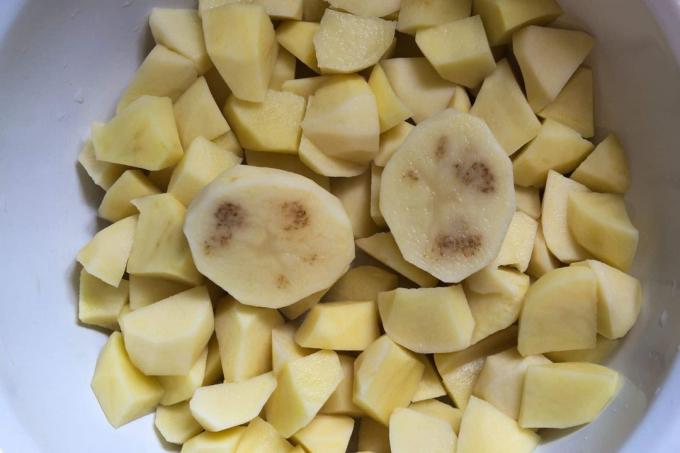
Potato is brown inside: is it edible?
After peeling or cooking, a potato has brown to black spots on the inside. This doesn't look very appetizing at first. And above all, the question arises as to whether the potato is still suitable for consumption or not. Since the causes of this discoloration can vary, in some cases it is due to […]

Black spots on potatoes: still use them?
Potatoes can have black spots. The potatoes are almost always edible despite the black spots. However, affected potatoes may show changes in taste and texture.
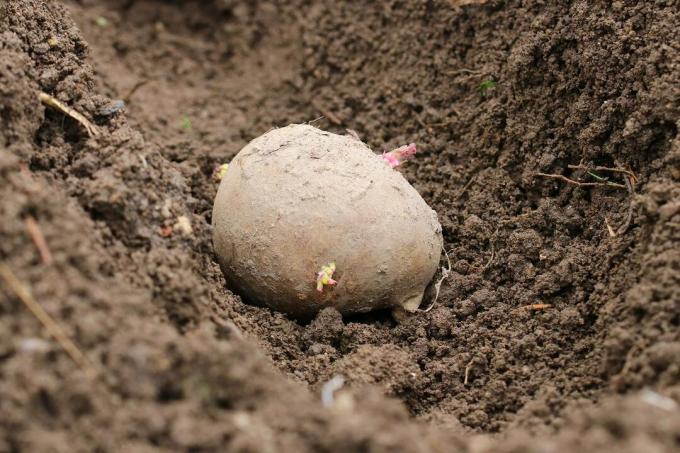
Time: from and until when do you plant potatoes?
Potatoes are among the most widely grown vegetables. So that self-cultivation works and a lush harvest can be brought in over many months, self-cultivators should pay attention to one important point: the right time to plant.

Planting potatoes: distance and depth
The potato (Solanum tuberosum) is a staple food with a wide range of preparation options. The tubers are indispensable in many dishes and are tastiest when you pick them yourself. What could be more obvious than growing them yourself. You can do this without your own garden.
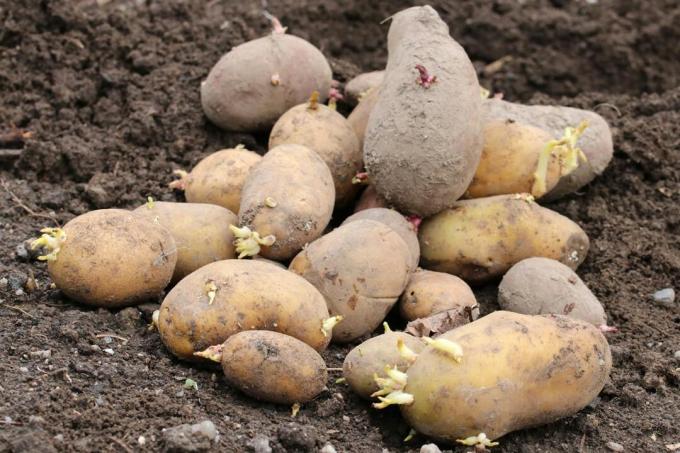
Mixed culture: 14 good neighbors of potatoes
German cuisine would be unthinkable without potatoes. Have you ever thought about growing the delicious tubers in your own garden? Use the advantages of a mixed culture! We present 14 plants that are suitable for mixed cultivation with potatoes.

Laying potatoes: ideal spacing and depth
Potatoes are good for the vegetable garden because they prepare the soil optimally for subsequent vegetables. They can also be stored for a long time and can be prepared in a variety of ways. You can read here which spacing is the right one for laying potatoes.



